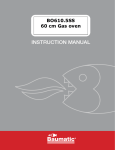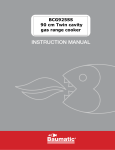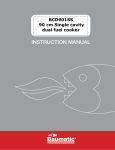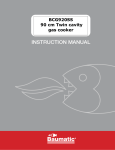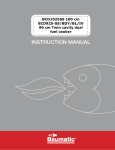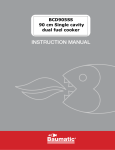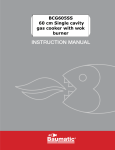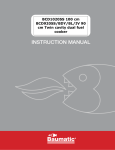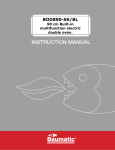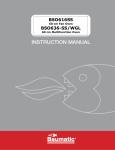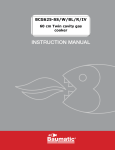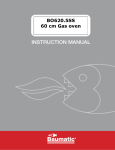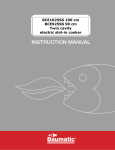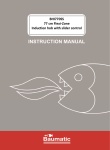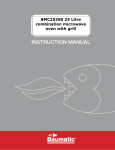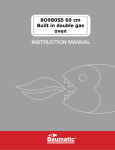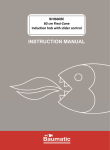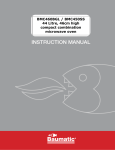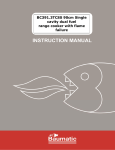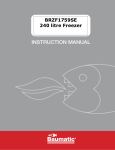Download Baumatic BCG905SS cooker
Transcript
BCG905SS 90 cm Single cavity gas range cooker y 1 User Manual for your Baumatic BCG905SS 90 cm Single cavity gas Range cooker NOTE: This User Instruction Manual contains important information, including safety & installation points, which will enable you to get the most out of your appliance. Please keep it in a safe place so that it is easily available for future reference; for you or any person not familiar with the operation of the appliance. JW 07/10/13 2 Contents Environmental note Important safety information 4 5–8 Specifications Dimensions Specifications Electrical details Gas details Control panel 9 – 11 9 9 - 10 10 10 11 Using the hob top Hob surface layout Before first use Lighting a burner Optimum use of the burners Hob guidelines 12 - 15 12 12 12 - 13 13 14 - 15 Using the oven Before first use Using the main oven Base burner appliances Cooking guidelines Warnings Cooking guide Cooking tips for cakes and bread Cooking tips for meat 15 - 20 15 16 17 18 18 19 – 20 20 – 21 21 Cleaning and maintenance Cleaning the gas hob top After each use Cleaning the burners Cleaning the oven Replacing the oven bulb Removing the oven door for cleaning Removing the inner door glass for cleaning Removing the side guide rails for cleaning 22 – 26 23 23 23 23 24 24 - 25 25 26 Installation Positioning Ventilation requirements Securing the back-guard Fitting the safety chain and hook Electrical connection Connecting the main supply cable Gas connection Gas safety (installation and use) regulations Gas connection Gas conversion to LPG for hob top Minimum flow adjustment for hob gas taps Gas conversion to LPG for the oven and grill Minimum flow adjustment for the oven burner Gas tap replacement 26 26 28 29 30 31 31 32 33 33 34 35 36 37 38 My appliance isn’t working correctly Baumatic consumables 39 – 41 42 Contact details 43 3 - 39 - 27 - 29 - 32 – 34 – 35 – 36 - 39 Environmental note o The packaging materials that Baumatic uses are environmentally friendly and can be recycled. o Please discard all packaging material with due regard for the environment. 4 Important safety information Your safety is of the utmost importance to Baumatic. Please make sure that you read this instruction booklet before attempting to install or use the appliance. If you are unsure of any of the information contained in this booklet, please contact the Baumatic Customer Care Department. General Information o This appliance is designed for domestic household use and for the cooking of domestic foodstuffs. o IMPORTANT: The adjacent furniture and all materials used in the installation must be able to withstand a minimum temperature of 85°C above the ambient temperature of the room it is located in, whilst in use. o Certain types of vinyl or laminate kitchen furniture are particularly prone to heat damage or discolouration at temperatures below the guidelines given above. o Any damage caused by the appliance being installed in contravention of this temperature limit, or by placing adjacent cabinet materials closer than 25 mm to the appliance, will be the liability of the owner. o IMPORTANT: Baumatic Ltd. DO NOT recommend that this appliance is installed on any type of marine vessel. o The use of this appliance for any other purpose or in any other environment without the express agreement of Baumatic Ltd. will invalidate any warranty or liability claim. o Your new appliance is guaranteed against electrical or mechanical defects, subject to certain exclusions that are noted in Baumatic’s Conditions Of Guarantee. The foregoing does not affect your statutory rights. o Repairs may only be carried out by Baumatic service engineers or their authorised service agents. Warning and safety instructions o This appliance complies with all current European safety legislation. Baumatic do wish to emphasise that this compliance does not remove the fact that the appliance surfaces will become hot during use and retain heat after operation. 5 o This appliance is not intended for use by persons (including children) with reduced physical, sensory or mental capabilities, or lack of experience and knowledge, unless they have been given supervision or instruction concerning use of the appliance by a person responsible for their safety. Child Safety o Baumatic strongly recommend that babies and young children are prevented from being near to the appliance and not allowed to touch the appliance at any time. During and after use, all surfaces will become hot. o If it is necessary for younger family members to be in the kitchen, please ensure that they are kept under close supervision at all times. General Safety Make sure that you understand the controls before using the appliance. Check that all of the controls on the appliance are turned off after use. Always stand back when opening the oven door, this will allow heat to disperse. Take care when removing items from the oven, as the contents may be hot. Always keep the oven doors closed when the oven is not in use. Always follow the basic principles of food handling and hygiene; this will prevent the possibility of bacterial growth. Always keep ventilation slots clear of obstructions. Keep fingers away from the hinge areas when closing the door, otherwise you may trap them. Oven gloves should be used when placing food in the oven cavity and when removing it. Care should be taken to avoid direct contact with any of the elements in the appliance. o DO NOT LEAVE THE APPLIANCE UNATTENDED WHILST IN USE. 6 o Do not place heavy objects on the oven door or lean on the oven door when it is open, as this can cause damage to the oven door hinges. Nobody should be allowed to sit or stand on any part of the cooker. o Do not store chemicals, food stuffs, pressurised containers in or on the cooker or in cabinets immediately above or next to the cooker. o Do not heat up unopened food containers, as pressure can build up which may cause the container to burst. o Do not place flammable or plastic items on or near the hob burners, these types of materials should also not be placed in the oven or the compartment below the oven. o Do not leave heated oil or fat unattended, as this is a fire risk. You should not fill a deep fat frying pan more than one third full of fat or oil; you should also not use a lid. o Do not allow fat or oil to build up in the oven trays, grill pan or oven base. o Do not place pans or baking trays directly on the base of the oven cavity, or line it with aluminium foil. o Do not grill food containing fat without using a grill trivet. The grill trivet should never be covered with aluminium foil. o Do not place hot parts in water, leave them to cool first. o Do not allow vinegar, coffee, milk, saltwater, lemon, tomato juice or any liquid with high sugar content to remain in contact with the enamel parts of the appliance. Spillages should be wiped up immediately. o Do not allow electrical fittings or cables to come into contact with areas on the appliance that get hot. o Do not use the appliance to heat the room it is located in or to dry clothing. No clothing should be placed over or near to the hob burners or oven door. o Do not install the appliance next to curtains or soft furnishings. o Do not attempt to lift or move cooking appliances by using the oven door or handle, as this may cause damage to the appliance or result in injury to the person lifting the appliance. 7 Cleaning o Cleaning of the oven should be carried out on a regular basis. o Great care should be taken whilst using this appliance and when following the cleaning procedure. o IMPORTANT: The appliance must be disconnected from the mains before following the cleaning procedure. o IMPORTANT: Care must be taken when cleaning between the door glasses, and inside the inner frame as some of the edges maybe sharp due to the manufacturing process. Installation This appliance must be correctly installed by a suitably qualified person, strictly in accordance with the manufacturer’s instructions. Please see the specific section of this booklet that refers to installation. o Baumatic Ltd. declines any responsibility for injury or damage, to person or property, as a result of improper use or installation of this appliance. o Heat, steam and moisture will be created during use of the appliance, take care to avoid injury and ensure that the room is adequately ventilated. If the appliance is going to be used for prolonged periods of time, then additional ventilation may be required. o Please consult with your qualified installer if you are in any doubt about the amount of ventilation that you will require. Declaration of conformity This appliance complies with the following European Directives: 2006/95/EC regarding “low voltage” 2004/108/EC regarding “electromagnetic disturbances” -89/109/EEC regarding “materials in contact with food”. o The above directives comply with 93/68/EEC regarding CE marking. o The manufacturer declares that the oven is built using certified materials and requires the appliance to be installed in accordance with the standards currently in force. This appliance must be used by a trained person for domestic purposes only. 8 Specifications Height = 885 - 940 mm Width = 900 mm Depth = 600 mm Product specifications: o o o o o 5 zone gas hob: 1 x 3.80 kW triple crown wok burner 1 x 3.00 kW rapid burner 2 x 1.80 kW semi-rapid burners 1 x 1.00 kW auxiliary burner o o o o o o o o o o Flame failure safety device on each burner Automatic ignition Heavy duty cast iron pan stands Flame failure safety device (oven) Fixed electric grill Separate light button Double-glazed removable door Removable full inner glass Wipe Clean enamelled cavity Adjustable feet Gas oven with electric grill o 2 functions o Net oven capacity: 89 litres o Gross oven capacity: 112 Litres 9 Standard accessories: o o o o o o Trivet WipeClean enamelled baking tray with handle 2 x Safety shelves Removable side racks LPG conversion jets Wok stand Optional extra: o BPS2 Pizza Stone o BT2GRID Griddle Plate With Handles Electrical details Rated Voltage: Supply Connection: Max Rated Inputs: Mains Supply Lead: Oven Light Bulb: 220 - 240 Vac 50 Hz 13A (double pole switched fused outlet with 3mm contact gap) 2.02 kW 3 core x 1.5 mm² E14 15 W/300°C screw type pygmy Gas details Gas Connection Type: Gas Type (Natural Gas): 1/2” BSP 20 mbar For future reference please record the following information which can be found on the rating plate and the date of purchase which can be found on your sales invoice. The rating plate for your oven can be located by opening the door of the storage compartment. Model Number ………………………………. Serial Number ………………………………. Date of Purchase ………………………………. 10 Control Panel Cooking zone dial o Turn the relevant dial anticlockwise to select a power level for a chosen burner. 0 = Burner OFF position – Low temperature – High temperature Gas oven and grill knob o Turn the dial anti-clockwise to select the fixed electric grill function. o Turn the dial clockwise to switch on the gas oven and continue turning to set the oven temperature. Analogue Thermometer o The control panel has an analogue thermostat which displays the approximate internal temperature of the main oven. 11 Using the hob top Hob surface layout 2) 3) 4) 6) 3.00 1.80 1.00 3.80 kW kW kW kW rapid burner semi-rapid burners auxiliary burner triple crown (wok) burner Before first use IMPORTANT: You should clean the hob surface (see “Cleaning and maintenance” section). o You should switch on one cooking zone at a time, for 5 minutes at the maximum setting. This will help to eliminate any new smell that exists and evaporate any humidity that has formed on the heating elements during transit. o Do not burn off more than one zone at once. o You must place a saucepan filled half full with cold water on each zone as you burn it off. Lighting a burner o Press the relevant burner dial and rotate anticlockwise to the large flame icon. Release the dial and the burner will automatically ignite. 12 o Matches can also be used to light the burner during a power cut. Simply follow the previous step but place a lit match to the burner as you press the dial. Once lit, keep the dial pressed for about ten seconds. WARNING: Extra care should be taken when lighting a burner with matches. There is a risk of burning as the cooking zone ignites so take necessary precautions. Optimum use of the burners o In order to achieve maximum results with the minimum consumption of gas, it is important to adjust the flame according to your needs and to use the appropriate size pans (see table below). o When the contents of a pan begin to boil it is recommended that you adjust the dial to the small flame position. o Always place a lid on the pan in use. Burner Diameter of pan (cm) Triple crown 22 – 24 Rapid 20 – 22 Semi-rapid 16 – 18 Auxiliary 12 - 14 o Always remember to turn the control knob to OFF when cooking is completed. o The appliance is equipped with pan supports (1), on which the wok support (2) must be placed. To ensure stability, position the notch (A) of the wok support on the pan support fingers as indicated in the diagram above. 13 Hob guidelines o The first few times the hob top is used, it may give off an acrid, burning smell. This smell will disappear completely with repeated use. o The worktop is fitted with cooking areas of different diameter and power. o The positions where the heat will radiate from are clearly marked on the hob top. The saucepans must be positioned exactly on these zones for efficient heating to occur. Pans should have the same diameter as the cooking zone that they are being used on. o You should not use saucepans with rough bottoms, as this can scratch the surface. o Before use, make sure that the bottoms of the saucepans are clean and dry. o When cold, the bottom of the pans should be slightly concave, as they expand when hot and lie flat on the surface of the hob. This will allow the heat to transfer more easily. o The best thickness for the bottom of the pans is 2 – 3 mm of enamelled steel and 4 – 6 mm for stainless steel with sandwich type bottoms. o If these rules are not followed, then there will be a great loss of heat and energy. Heat not absorbed by the saucepan, will spread to the hob, frame and surrounding cabinets. o Preferably cover pans with a lid to permit cooking at a lower heat. o Always cook vegetables and potatoes, etc. in as little water as possible to reduce cooking times. 14 o Food or liquid that has a high sugar content may damage the hob top if it comes into contact with the hob surface. Any spillages should be wiped up immediately, however this may not prevent the hob surface from becoming damaged. o IMPORTANT: The hob surface is tough; however it is not unbreakable and can be damaged. Especially if pointed or hard objects are allowed to fall on it with some force. o DO NOT USE THE HOB IF THE SURFACE BECOMES BROKEN OR CRACKED. YOU SHOULD CONTACT THE BAUMATIC SERVICE DEPARTMENT IMMEDIATELY. Using the oven Before first use o To remove any residue from the oven that may have been left from the manufacturing process, you should select either the main or grill oven function and turn the thermostat dial to its maximum temperature setting. o It is perfectly normal for a smell to be produced during this process. o You should make sure that any windows in the room are left open during this process. o It is advisable for you not to remain in the room whilst the burning off process is taking place. o You should leave each oven on maximum setting for 30 – 40 minutes. o IMPORTANT: You simultaneously. should not burn off both ovens o After both cavities have cooled, they should then be cleaned with warm soapy water, using either a sponge or soft cloth. No abrasive cleaners should be used. o Outer parts of the oven should be cleaned with warm soapy water, using either a sponge or soft cloth. No abrasive cleaners should be used. o We would recommend that an appropriate stainless steel cleaner and polish is regularly used on the stainless steel surfaces of this appliance. 15 Using the main oven o You can rotate this dial anticlockwise to select the fixed electric grill function. o You can also turn the dial clockwise to switch on the gas oven and then proceed to set the oven temperature. REMEMBER: When using the grill function, it is important to place a drip pan at the base of the oven cavity to collect any juices which may drip down (see image below). The oven walls are fitted with various guide bars on which you can place an oven shelf or a drip tray (see image below). 16 Base burner appliances IMPORTANT: Your appliance is a Continental style/base burner gas oven, please follow the guidance below, to achieve the best cooking results. o There are two different types of heating methods for gas ovens, traditional U.K. style and Continental style. o In U.K. style gas ovens, the hot air moves around the oven and the hottest part of the cavity is at the top. o In Continental style gas ovens, the heat source is underneath the base of the oven, which means that the hottest part of the cavity is at the bottom. o Your oven is a Continental style gas oven, which may require some adjustment in your cooking method, if you are used to a U.K. style gas oven. o We would recommend that you place the enamelled baking tray into the lowest shelf position. o This will deflect some of the fierce heat generated by the base burner away from the food that you are cooking. o This will allow food to cook all of the way through, without getting burnt on the base. o You may also need to make small adjustments to the cooking temperature and cooking times that you normally used previously. 17 Cooking guidelines o Please refer to the information given on food packaging for guidance on cooking temperatures and times. Once familiar with the performance of your appliance, temperatures and times can be varied to suit personal preference. o Make sure that frozen foods are thoroughly thawed before cooking, unless the instructions on the food packaging advise that you can “cook from frozen”. o You should pre-heat the oven and not place food inside of it until it is properly heated. o Before cooking, check that any unused accessories are removed from the oven. o Place cooking trays in the centre of the oven and leave gaps between the trays to allow air to circulate. o Try to open the door as little as possible to view the dishes. Warnings o Keep the oven door closed when using either the grill or oven functions. o During cooking, never place pans or cookware directly onto the bottom of the oven. They should always be placed on the shelves provided. o The grill heating element becomes extremely hot during operation, avoid touching it inadvertently when handling the food which you are grilling. o Important: Be careful when opening the door, to avoid contact with hot parts and steam. o IMPORTANT: In case of fire, close the main valve of the gas supply and switch off the electricity supply to the appliance. NEVER pour water onto burning oil. For general cooking guides for each of the ovens, please see the tables on the following page. 18 Cooking guide Multifunction oven: Foods Weight (kg) Meat Roast veal Roast beef Roast pork Roast lamb Game Roast hare Roast pheasant Roast partridge Poultry Roast chicken Roast turkey Roast duck Fish Roast fish Casserole fish Baked pasta Lasagne Cannelloni Pizza Bread Pastries Biscuits in general Shortcrust pastry Victoria sponge Cakes Angel cake Fruit cake Chocolate cake Shelf position from bottom With 5 With 4 With runners runners three runners Cooking without fan Temperature Cooking (°C) time in mins Cooking with fan Temperature Cooking (°C) time in mins 1 1 1 1 1-2 1-2 1-2 1-2 1-2 1-2 1-2 1-2 2 1 2 1 200-225 200-225 200-225 200-225 100-120 40-50 100-120 100-120 190 190 190 190 100-120 40-50 100-120 100-120 1 1 1-2 1-2 1-2 1-2 2 2 200-MAX 200-MAX 50-60 60-70 200-MAX 200-MAX 50 60 1 1-2 1-2 2 200-MAX 50-60 200-MAX 50 1 1-2 1-2 2 200-225 80-90 190 70-80 1 1-2 1-2 2 200-225 100-120 190 90-110 1 1-2 1-2 2 200-225 90-110 190 80-100 1 1 2-3 2-3 2 2 1 1 200 175 30-35 20-25 170-190 160-170 25-30 15-20 2.5 2.5 1 1 3 3 3 3 2 2 2 2 1 1 1 1 210-225 210-225 225-MAX 225-MAX 60-75 60-75 25-30 20-25 225-MAX 225-MAX 225-MAX 220 30-40 30-40 20-25 20 2 2 1 190 15 170-190 15 2 2 1 200 20 190-200 20 0.8 2 2 1 200 40-45 190-200 40-45 0.8 0.8 0.8 2 2 2 2 2 2 2 2 2 190 200 200 52 65 45 170-190 190-200 190-200 45 65 45 The information in this table is approximate and may vary according to individual needs. 19 Grilling: Shelf position from bottom Foods Meat Chop Beef Steaks Half chicken (0.5kg each half) Fish Trout Sole Bread Toast Weight (kg) With 5 runners With 4 runners With 3 runners Cooking without fan Cooking time in Temperature mins (°C) 2nd 1st side side 0.50 3 3 2 225-MAX 0.15 3-4 3 1-2 1 3-4 2-3 1-2 0.42 0.20 200-225 1215 5 1215 5 225 20 20 4 4 3 3 2-3 2-3 225-MAX 225-MAX 4-5 3-4 3 225-MAX 2-3 2-3 Cooking with fan Cooking time in Temperature mins (°C) 2nd 1st side side 200 15 Depends on thickness and personal taste Depends on thickness and personal taste 200 200 10 7 10 7 200 2-3 2-3 The information in this table is approximate and may vary according to individual needs. Cooking tips for cakes and bread o Heat the oven for at least 15 minutes before you start cooking bread or cakes. o Do not open the door during baking because the cold air will stop the yeast from rising. o When the cake is cooked turn the oven off and leave it in for about 10 minutes. o Do not use the enamelled baking tray or drip pan to cook cakes in. o To test if a cake is cooked, about 5 minutes before the end of cooking time, put a cake tester or skewer in the highest part of the cake. If it comes out clean, the cake is cooked. o If the cake sinks, next time use less liquid or lower the temperature by 10°C. o If the cake is too dry, make some tiny holes with a toothpick and pour some drops of fruit juice or spirits on it. The next time, increase the temperature by 10°C and set a shorter cooking time. 20 10 o If the cake is too dark on top next time put the cake on a lower shelf and cook it at a lower temperature for longer. o If the top of the cake is burnt, cut off the burnt layer and cover with sugar or decorate with cream, jam and confectioner’s cream. o If the cake is too dark underneath next time place it on a higher shelf and cook it at a lower temperature. o If the cake or bread is cooked nicely outside but is still uncooked inside, next time use less liquid and cook at a lower temperature for longer. o If the cake will not come out of the tin, slide a knife around the edges, place a damp cloth over the cake and turn the tin upside down. Next time, grease the tin well and sprinkle with flour or bread crumbs. o If the biscuits will not come away from the baking tray, put the tray back in the oven for a while and lift the biscuits up before they cool. The next time use a sheet of baking parchment to prevent this happening again. Cooking tips for meat o If, when cooking meat, the time needed is more than 40 minutes, turn the oven off 10 minutes before the end of cooking time to exploit the residual heat and save energy. o Your roast will be juicer if cooked in a closed pan. It will be crispier if cooked without a lid. o Normally white meat, poultry temperatures (less than 200°C). and fish need medium o To cook “rare” red meats, high temperatures (over 200°C) and short cooking times are needed. o For a tasty roast, lard and spice the meat. o If your roast is tough, next time leave the meat to ripen longer. o If your roast is too dark on top or underneath, next time put it on a higher or lower shelf, lower the temperature and cook for longer. o If your roast is undercooked, cut it in slices and arrange the slices on a baking tray with gravy and finish cooking it. 21 Cleaning and maintenance Cleaning operations must only be carried out when the oven is cool. The appliance should be disconnected from your mains supply before commencing any cleaning process. o The oven should be thoroughly cleaned before it is operated for the first time and after each use. This will avoid residual food stuffs becoming baked on the oven cavity. After residues have been baked on several times, they are far more difficult to remove. o Never clean the oven surfaces by steam cleaning. o The oven cavity should only be cleaned with warm soapy water, using either a sponge or soft cloth. No abrasive cleaners should be used. o Any stains that may appear on the bottom of the oven will have originated from food splashes or spilt food, these splashes occur during the cooking process. These could possibly be a result of the food being cooked at an excessively high temperature or being placed in cookware that is too small. o You should select a cooking temperature that is appropriate for the food that you are cooking. You should also ensure that the food is placed in an adequately sized dish and that you use the enamelled baking tray where appropriate. o Outer parts of the oven should only be cleaned with warm soapy water, using either a sponge or soft cloth. No abrasive cleaners should be used. o We would recommend that an appropriate stainless steel cleaner and polish is regularly used on the stainless steel surfaces of this appliance. o Do not use harsh or abrasive cleaners or sharp metal scrapers to clean the oven door glass since they can scratch the surface which may result in shattering. o If you use any form of oven cleaner on your appliance, then you must check with the manufacturer of the cleaner that it is suitable for use on your appliance. o Any damage that is caused to the appliance by a cleaning product will not be fixed by Baumatic free of charge, even if the appliance is within the guarantee period. 22 Cleaning the gas hob top o Remove the dirty pan supports from the hob and place in warm soapy water for some time. Then wash and dry before replacing. After each use o Wipe the appliance over with a damp cloth and a little washing up liquid. o Dry the appliance by rubbing the surface with a clean cloth. Cleaning the burners o Gas burners should be cleaned regularly and after each spillage to remove cooking residues and dirt. o To clean the burners, remove the caps and rings and place them separately in warm soapy water. After cleaning them, check that the burner ports are clear. o The body near the nozzle should always be clean. Dirt accumulating around the nozzle may clog it, as a result of which the burner will not light or will light only with a small flame. To clean the nozzle use a brush soaked in solvent. o Dry all the elements of the burner carefully as wet elements may not light properly. Assemble the clean and dry burners carrying out the disassembly steps in reverse order. Cleaning the oven o The oven compartment is coated with vitreous enamel. To clean particularly difficult burnt spots a special oven cleaning agent may be used. However, as these agents are caustic, be careful when using them and follow the manufacturer’s guidelines. Warning: Do not steam pressure clean the oven. Always wait until the oven cools down before cleaning. 23 Replacing the oven bulb IMPORTANT: The oven must be disconnected from your mains supply before you attempt to either remove or replace the oven bulb. o Draw out the side guide rails in order to provide access to the bulb. o Remove the glass protection cap (C) from the bulb socket by lifting it with a screwdriver placed between the cap and the oven wall. o Replace the bulb (B) with W/300°C, screw type pygmy. a 15 o Do not use any other type of bulb. o Screw the lamp cover back into its original position. Removing the oven door for cleaning o The oven door can be removed to give easier access to the oven when cleaning. o Open the oven door and insert a rivet or nail (R) in the hole (F) of the hinge (see image below). o Partially close the door, forcing it upwards at the same time to free the stop tooth and hinge sector. o Once the hinge is free, pull the door forwards tilting it slightly upwards to free the sector. o To reassemble, proceed in the reverse order, playing attention to the correct position of the sectors. 24 Removing the inner door glass for cleaning Ensure the top cavity is cold before cleaning. o Simply open the oven door and remove the support securing the glass. The glass will then slide out easily. o To replace the glass, follow the first step in reverse. WARNING: This procedure can be carried out with the door fitted on the appliance but pay attention that when the glass is pulled upwards, the force of the hinges can close the door roughly. o IMPORTANT: You should make sure that the door is supported at all times and that you place the door on some padded material whilst cleaning it. o The oven door and door glass should only be cleaned using a damp cloth and a small amount of detergent. The cloth MUST NOT have come into contact with any form of cleaning product or chemical previously. Removing the side guide rails for cleaning o For an effective cleaning of the oven side guide rails, these can be extracted by unscrewing the knurled nuts. o To fit the rails back in their place, first insert rear pins in the holes and then secure them with the knurled nuts. 25 Installation The installation must be carried out by a suitably qualified person, in accordance with the current version of the following. o UK Regulations and Safety Standards or their European Norm Replacements. o Building Regulations (issued by the Department of the Environment). o Building Standards (issued by the Scottish Development Department). o IEE Wiring Regulations. o Electricity At Work Regulations. o Gas Safety (Installation and Use) (Amendment) Regulations. Positioning The adjacent furniture and all materials used in the installation must be able to withstand a minimum temperature of 85°C above the ambient temperature of the room it is located in, whilst in use. o Your appliance is heavy, so you should be careful when moving or positioning it. o Do not try to move the cooker by pulling on either the door, handle or control panel. o It can also be used as freestanding, with a cabinet to one side, in a corner setting or with its back to a wall. 26 o IMPORTANT: It should not be installed at the end of a run of cabinets, if there is a cabinet at immediate right angles to the cooker door. o The wall behind the cooker and 450 mm above and across the width of the cooker should be an incombustible material and preferably an easy clean surface, such as ceramic tiles. o Any overhanging surface or cooker hood should be at least 700 mm above the highest point on the hob top (including the burners). o Baumatic do not recommend that the cooker is positioned below wall cupboards, as the heat and steam from the appliance and what is being cooked, may damage the cupboard and its contents. o The cooker may be located in a kitchen, or a bedroom, but not in a room containing a bath or shower. The cooker must not be installed in a bedroom of less than 20m³ in size. o The cooker is fitted with four legs that can be adjusted to match the height of your kitchen cabinets. o If the cooker is not level or is unstable due to an uneven floor surface, use the adjustable feet to alter each corner until the cooker is level. o To assemble them it is necessary to raise the cooker and to screw the four legs into position, on each corner of the base of the appliance. o IMPORTANT: They must be screwed clockwise into position and not just slotted into the holes on each corner. You must screw them through the brackets that are also provided. 27 Ventilation requirements o The room containing the cooker should have an air supply in accordance with the current edition of BS 5440: Part 2: o The room must have opening windows or equivalent; some rooms may also require a permanent vent. o If the room has a volume between 5 and 10m³, it will require an air vent of 50cm² (effective area). Unless it has a door which opens directly to the outside. o If the room has a volume of less than 5m³, it will require an air vent of 100cm² (effective area). o If there are any other fuel burning appliances in the same room the current edition of BS 5440: Part 2: should be consulted to determine air vent requirements. o Ensure that the room containing the cooker is well ventilated, keep natural ventilation holes or install a mechanical ventilation device (mechanical cooker hood). o Prolonged intensive use of the appliance may call for additional ventilation, either by the opening of a window, or by increasing the level of the mechanical ventilation device (where present). 28 o This cooker is not fitted with a device for discharging the products of combustion. Ensure that the ventilation rules and regulations are followed. o Excess steam from the oven, vents out at the top back edge of the cooker, so make sure that the walls behind and near the cooker are resistant to heat, steam and condensation. o Your cooker must stand on a flat surface so that when it is in position the hob is level. When in position check that the cooker is level by using a spirit level and adjust the 2 feet at the rear and the 2 feet at the front if necessary. o Remember that the quantity of air necessary for combustion must never be less than 2m³/h for each kW of power (see total power in kW on the appliance rating plate). Securing the back-guard o In order to attach the back-guard (A) to the appliance, you need to loosen the screws (B) positioned on the back of the hob (see image below). o Fix the back-guard into place by screwing the screws back into the hob with the back-guard placed in between. 29 Fitting the safety chain and hook o To prevent the cooker from tipping forward, two lengths of chain MUST BE fixed to the back of the oven which should be secured to the hook provided at all times. o The hook should be secured to the wall at the back of the cooker. The chains should always be attached to the upper hook when the cooker is in position against the wall. o Attach the chain to the lower hook if the cooker is installed with a hose assembly so that there is no strain on the hose when the cooker is pulled forward for cleaning or maintenance. o Fix the upper hook into the wall immediately behind and to the left hand side about 770 mm from the floor. o Secure the chain to the hook before using or cleaning the oven. To prevent strain on the flexible hose assembly, a lower chain and hook can be fixed approximately 100 mm up from the floor 30 Electrical connection YOUR COOKER IS INTENDED PERMANENT INSTALLATION. FOR FITTED AND o Before connecting the appliance, make sure that the supply voltage marked on the rating plate corresponds with your mains supply voltage. o We recommend that the appliance is connected by a qualified electrician, who is a member of the N.I.C.E.I.C. and who will comply with the I.E.E. and local regulations. o WARNING: THIS APPLIANCE MUST BE EARTHED. o This appliance is supplied with a moulded plug, which must be connected to an earthed socket. o If in future you need to change the fuse in this plug, then a 13 amp ASTA approved (BS 1362) fuse must be used. o If the earthed socket is not accessible after the appliance is installed. Then the cooker must be wired into a 13 A double pole switched fused spur outlet, having 3 mm contact separation and the fuse rating reduced to 3 amps. This should be placed in an easily accessible position adjacent to the appliance. The spur outlet must still be accessible even when your cooker is installed. o The wiring in the mains lead is coloured as follows: Brown Blue Green and yellow Live Neutral Earth o As the colours of the wires in the appliance’s mains lead may not correspond with the coloured markings identifying the terminals in your spur box, please proceed as follows: The brown wire must be connected to the terminal marked “L” (live), or coloured red. The blue wire must be connected to the terminal marked “N” (neutral), or coloured black. 31 The green and yellow wire must be connected to the terminal marked “E” (earth), or by the earth symbol, or coloured green and yellow. o When the connection is completed, no stray strands or cut wire should be present. The cord clamp must be secured over the outer sheath. o Broken or damaged power leads must only be replaced by a suitably qualified person. A power lead of a similar type must be used in replacement. Gas connection This appliance must be installed by a competent person in accordance with the current versions of the following UK (United Kingdom) or ROI (Republic of Ireland) Regulations and Safety Standards or their European Norm Replacements. Important information o This cooker is supplied to run on natural gas only and cannot be used on any other type of gas without modification. o Conversion for use on LPG and other gases must only be undertaken by a qualified person. For information on the use of other gases, please contact the Baumatic Technical Department. o The cooker must be installed by a qualified person, in accordance with the current edition of the Gas Safety (Installation and Use) (Amendment) Regulations and the relevant building/I.E.E. Regulations. o Failure to install the appliance correctly could invalidate Baumatic’s guarantee and lead to prosecution under the regulations quoted above. o In the UK, GASSAFE registered installers are authorised to undertake the installation and service work, in compliance with the above regulations. 32 Gas Safety (Installation and Use) Regulations o It is the law that all gas appliances are installed by competent persons in accordance with the current edition of the Gas Safety Installation and Use Regulations. o It is in your interest and that of safety to ensure compliance with the law. o In the UK, GASSAFE registered installers work to safe standards of practice. The cooker must also be installed in accordance with the current edition of BS 6172. Failure to install the cooker correctly could invalidate the warranty, liability claims and lead to prosecution. o IMPORTANT: It is a requirement for a stability chain to be fitted to the appliance. Please see page 28 for more detailed information on this. Gas connection ALL INSTALLATION AND SERVICE WORK MUST BE CARRIED OUT BY A GASSAFE REGISTERED ENGINEER. o Prior to installation, ensure that the gas supply conditions (nature of the gas and gas pressure) and the adjustment conditions are compatible. The adjustment conditions for this appliance are stated on the rating plate which can be found on the back cover. o This appliance is not designed to be connected to a combustion product evacuation device. Particular attention should be given to the relevant requirements regarding ventilation. o IMPORTANT: THE FIBRE WASHERS MUST BE IN PLACE WHEN CONNECTING THE ADAPTOR ELBOW. o Connect the short transition pipe to the elbow, inserting the washer. Connect the brass adapter with the test point to the nut of the transition pipe, inserting the washer. Then fix the retention device with the screw. o Connection to the cooker should be made with an approved appliance flexible connection to BS 669. o If the cooker has been converted for use with LPG, then it should be connected to the gas supply using an appropriate bayonet type hose. The hose MUST be suitable for use with LPG gas, these are identifiable by a red band or stripe. 33 o A hose length of 0.9m to 1.25m is recommended. The length of hose chosen should be such that when the cooker is in situ, the hose does not touch the floor. o Care should be taken to ensure that the temperature rise of areas at the rear of the cooker that are likely to come in contact with the flexible hose do not exceed 70°C. o Gas pressure may be checked on a semi-rapid hob burner. Remove the appropriate injector and attach a test nipple. Light the other burners and observe that the gas pressure complies with the gas standards in force. o This cooker can be connected to the supply both on the right and left hand side at the rear of the cooker. To reverse the position, remove the blanking plug and refit it to the opposite side to where the hose is being connected. Gas adjustment (Conversion to LPG for the hob top) All work must be registered engineer. carried out by a GASSAFE IMPORTANT: Always isolate the cooker from the electricity supply before changing the injectors and/or adjusting the minimum flow of the burners. o Remove the pan-stands, burners and flame spreaders (A). o Unscrew the injector (B) and replace it with the stipulated injector for the new gas supply (see table below). o Reassemble all the burners carefully; in particular you should make sure that the flame spreader is correctly placed on the burner. 34 IMPORTANT: After changing the injectors YOU MUST follow the minimum flow adjustment section below. BURNERS Rapid Semi-rapid Auxiliary Ultra-rapid Oven OPERATING PRESSURE GAS GAS MBAR LPG Butane LPG Propane Natural LPG Butane LPG Propane Natural LPG Butane LPG Propane Natural LPG Butane LPG Propane Natural LPGButane LPG Propane Natural RATE g/h L/h DIAMETER INJECTOR 1/100 mm HEAT INPUT MIN MAX 28-30 218 88 800 3000 37 214 88 800 3000 800 600 3000 1800 20 28-30 131 117-Y 68 37 129 68 600 1800 20 28-30 73 98-Z 51 600 400 1800 1000 37 71 51 400 1000 20 28-30 276 75-X 98 400 1600 1000 3800 37 272 98 1600 3800 20 28-30 284 135-K 94 1600 1000 3800 3900 37 279 94 1000 3900 142 1000 3900 20 286 171 95 362 371 BY-PASS 1/100 mm 44 34 28 62 52 Minimum flow adjustment for hob gas taps. All work must be carried out by a GASSAFE registered engineer. o Light the burner and set the knob at the minimum position. o Remove the knob from the tap. The adjustment screw is located beside the valve body. o Unscrew the adjusting screw, in order to increase the gas flow or tighten the adjusting screw to decrease the gas flow. o The correct adjustment is obtained when the flame has a length of about 3 – 4 mm. o For butane/propane gas, the adjusting screw must be tightly screwed in. 35 o Refit the control knob. o Make sure that the flame does not go out by quickly turning from maximum flow to minimum flow. If it does then remove the control knob and make further adjustments to the gas flow, testing it again once the adjustment has been made. o IMPORTANT: On completion carry out a gas tightness test. Gas adjustment (Conversion to LPG for the oven and grill) All work must be carried out by a GASSAFE registered engineer. IMPORTANT: Always isolate the cooker from the electricity supply before changing the injectors and/or adjusting the minimum flow of the burners. o Free the burners from their fixing screws. o Unscrew the injectors and replace them with the stipulated injector for the new gas supply (see table on page 33 - 34). IMPORTANT: You must change the oven and grill injectors. IMPORTANT: After changing the injectors YOU MUST follow the minimum flow adjustment section below. 36 Minimum flow adjustment for the oven burner All work must be carried out by a GASSAFE registered engineer. o Remove the thermostat knob. o Switch on the oven burner by turning the relative knob to the maximum position then wait for about 10 minutes. o Slowly turn the knob back to the minimum position and, using a small screwdriver, turn the screw to the right to lower the flame or to the left to increase it. o The flame must be short for an efficient reduced rate setting. They must be stable to prevent them from accidently going out so they must be able to withstand normal oven door manoeuvres. o To adjust the primary air, light the burner. While watching the flame, loosen the screw and adjust the sleeve the obtain 2.5 mm for natural gas and 3 mm for LPG. o Lock the screw in place once the adjustments have been made. o IMPORTANT: On completion carry out a gas tightness test. 37 Gas tap replacement All work must be registered engineer. carried out by a GASSAFE IMPORTANT: Always isolate the cooker from the electricity supply before changing the gas taps. o Remove all pan supports and burner heads. o Unscrew the burner fixing screws (A) (four for the triple crown burner and two for all others) as shown in the diagram on the next page. o Pull out the knobs. o Unscrew the six fixing screws (B) which lock the side profiles and remove it. o Remove the hob by unscrewing the rear fixing screws (B) which lock the hob at the supports (C). o Unscrew the nuts (E) of the gas aluminium pipes and pull out the thermocouple quick connectors (F). o Unscrew the screws (D) which lock the crosspieces. o Unscrew the screws (G) which unite the bridles of the taps to the front frame. 38 o Slip the ramp towards the back part and unscrew the screws (G) in order to free the taps. o Change the seal each time a tap or a thermostat is replaced. This will ensure perfect retention between the tap or a thermostat and part. o Reassemble all the parts following the same procedure but in the reverse order. My appliance isn’t working correctly o The oven isn’t coming on. * Check that the oven is in manual operation mode. * Check that you have selected a cooking function and a cooking temperature. o There appears to be no power to the oven and grill. * Check that the appliance has been connected to the electrical mains supply correctly. * Check that the mains fuses are in working order. * Check that the operating instructions for setting the time of day and putting the appliance into manual operation mode have been followed. o The grill function works but the main oven does not. * Check that you have selected the correct cooking function. o The grill and top oven element is not working, or cuts out for long periods of time during use. * Allow the oven to cool for approximately 2 hours. Once cool, check whether the appliance is again working properly. o My food is not cooking properly * Ensure that you are selecting the correct temperature and the correct cooking function for the food that you are cooking. It may be appropriate to adjust your cooking temperature to achieve the best cooking results. 39 o My food is not cooking evenly * Check that the oven has been installed correctly and is level. * Check that the correct temperatures and shelf positions are being used. o The oven light is not working * Refer the “Replacing the oven bulb” section. o I am getting condensation in my oven * Steam and condensation is a natural by product of cooking any food with high water content, such as frozen food, chicken etc. * You may get condensation in the oven cavity and forming between the oven door glasses. This is not necessarily a sign that the oven is not working correctly. * Do not leave food in the oven to cool after it has been cooked and the oven has been switched off. * Use a covered container, where practical, when cooking to reduce the amount of condensation that forms. 40 IMPORTANT: If your appliance appears not to be operating correctly, then you should disconnect it from your mains supply and then contact Baumatic Customer Care on telephone number (0118) 933 6911. DO NOT ATTEMPT TO REPAIR THE APPLIANCE YOURSELF. Please note that if an engineer is asked to attend whilst the product is under guarantee and finds that the problem is not the result of an appliance fault, then you may be liable for the cost of the call out charge. The appliance must be accessible for the engineer to perform any necessary repair. If your appliance is installed in such a way that an engineer is concerned that damage will be caused to the appliance or your kitchen, then they will not complete a repair. This includes situations where appliances have been tiled in, sealed in with sealant, have wooden obstructions placed in front of the appliance - like plinths, or any installation other than the one specified by Baumatic Ltd. has been completed. Please refer to the conditions of guarantee that appear on the warranty card that you receive with the appliance. 41 Baumatic Consumables o BC001 Degreaser for Dishwashers (200 g) o BC002 Descaler for Washing Machines and Dishwashers (200 g) o BC003 Ceramic Hob Cleaner (250 ml) o BC004 Oven Cleaner (250 ml) o BC005 Stainless Steel Cleaner and Protector (250 ml) o BC007 E-Cloth – General Purpose Cloth o BC008 Microwave Cover To order a Baumatic consumable product please call 0123 5437 244 and quote the product code. You can also order online from eshop.baumatic.co.uk 42 Czech Republic/Slovakia Baumatic s.r.o. United Kingdom Baumatic Ltd., Baumatic Buildings, 6 Bennet Road, Reading, Berkshire RG2 0QX United Kingdom Lípová 665/1 460 01 Liberec 4 Czech Republic Panenská 34 811 03 Bratislava - Staré Mesto Slovakia Sales Telephone (0118) 933 6900 Sales Fax (0118) 931 0035 Customer Care Telephone (0118) 933 6911 Customer Care Fax (0118) 986 9124 Spares Telephone (01235) 437244 Advice Line Telephone (0118) 933 6933 +420 483 577 200 (CZ) +421 255 640 618 (SK) www.baumatic.cz www.baumatic.sk Germany Kundendienst & Ersatzteile Deutschland 0049(0)180-5888975 Oesterreich +43 (0) 820 / 420423 E-mail: [email protected] [email protected] [email protected] [email protected] www.baumatic.de +49 (0) 5223 99408 0 www.baumatic.de Website: www.baumatic.co.uk Italy Baumatic Italia S.R.L. Via Galvani N.3 35011 Campodarsego (PD) Facebook: www.facebook.com/baumatic.uk Republic of Ireland +3904 9920 2297 www.baumatic.it Service Telephone 1-890 812 724 Holland Baumatic Benelux B.V. Dukdalfweg 15d 1332 BH ALMERE Nederland Spares Telephone 091 756 771 +31(0)36 549 1553/1555 www.baumatic.nl 43 44












































